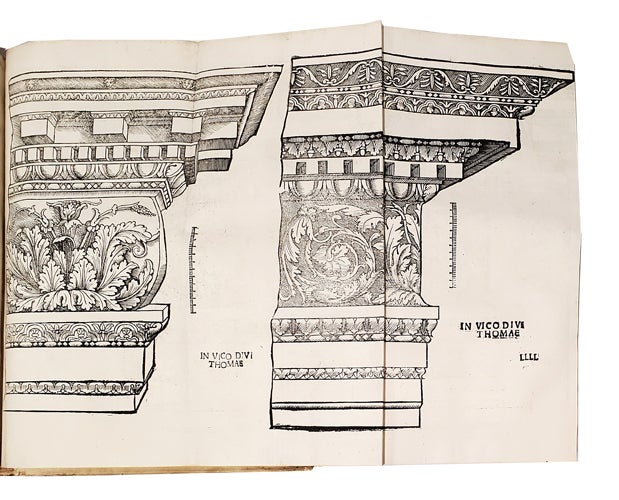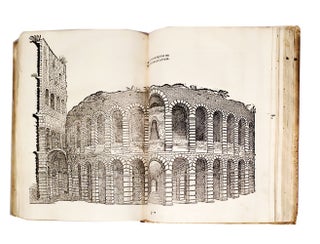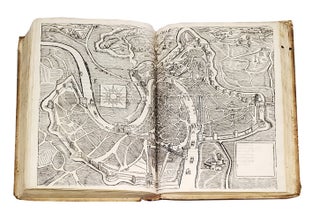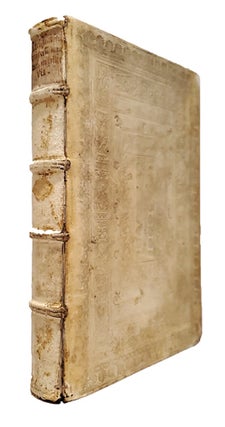De Origine et amplitudine civitatis Veronae.
SARAYNA, Torelli. De Origine et amplitudine civitatis Veronae. 70 leaves including illustrations, erratic pagination (see below). Illustrated with woodcut printer's device on the title, woodcut portrait of the author and 26 woodcut plates, many double-page or fold-out plates, with several in-text woodcuts designed by Giovanni Caroto. Verona: Ex Officina Antonii Putelleti, 1540. BOUND AFTER:
GIUSTIANI, Petrus. Rerum Venetarum ab urbe condita historia. [24], 488 pp. Small folio, 310 x 210 mm, bound in contemporary blind stamped alum tawed pigskin. Preserved in a blue half morocco folding box Venice: Comin da Trino 1560.
Ad 1. First Edition. A Renaissance guide to the antiquities of Verona with illustrations designed by the artist Giovanni Caroto including a handsome woodcut portrait of the author, Torelli Sarayna, signed with Caroto's monogram. The large-scale woodcuts illustrate buildings, plans, inscriptions and details of the extensive Roman ruins plus a woodcut map of the area surrounding Verona. The most impressive is the large fold-out plate depicting Verona's famous the Roman amphitheater. The panoramic plate, measuring 400 x 890 mm and comprising three woodblocks on three conjoined sheets, cleverly shows both the interior and exterior of the structure. Built in 30 A.D., the amphitheater is still in use today as a venue for opera, theater, and concerts.
Giovanni Caroto (1488-1555?) was from a family of Veronese artists. His older brother Giovanni Francesco Caroto (1480-1555) was an accomplished artist and follower of Mantegna. The younger Caroto was a follower of Liberale da Verona and is perhaps most well known for his contribution to the present work. Most interestingly, as noted in Mortimer, Vasari makes reference to the book and notes that Caroto sent him a copy.
The unusually large format of the woodcuts provides both a dynamic viewing experience and a bit of a bibliographical conundrum. Many of the woodcuts spread over entire uncut sheets bound as folding plates, and because they are counted in the collation this often leads to erratic signatures and pagination, and confusion over the plate count. The references call for 29 full- or double-page illustrations, however this can be confusing depending on the way in which each particular copy is bound and what is counted as a separate plate. See Mortimer.
Ad 2. First Edition of this popular history of Venice by the Venetian senator and hisorian Pietro Giustinian (1490-1576). The history references fellow Venitian chronicalers such as Adnrea Dandolo and Pietro Bembo and reccounts both the cultural and political events of the grand city.
One folding plate with a clean mended tear. Spine rubbed and top hinge cracked, but sound. All together a fine wide margined sammelband of two important works in an appealing contemporary binding.
Ad. 1. Mortimer, Italian 462. Cicognara 4089. Fowler 232-233. Brunet V, 139.
Ad. 2. Adams J-711. BM/STC Italian, p. 363.
Item nr. 168506
Price:
$12,500.00




